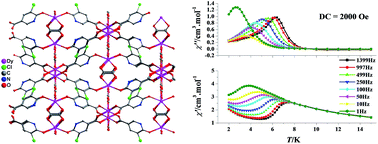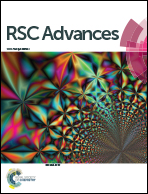Slow magnetic relaxation of a three-dimensional metal–organic framework featuring a unique dysprosium(iii) oxalate layer†
Abstract
A novel lanthanide metal–organic framework was yielded by a hydrothermal reaction of 5-chloro-6-hydroxypyridine-3-carboxylic acid (5-Cl-6-HOPy-3-CO2H) and Dy2O3 in the presence of oxalic acid [H2(OX)], namely, {[Dy2(1H-5-Cl-6-Opy-3-CO2)2(OX)2(H2O)]·2H2O}∞ (1, 1H-5-Cl-6-Opy-3-CO2− = 1-hydro-5-chloro-6-oxopyridine-3-carboxylate, which was formed by the autoisomerization of single deprotonated 1H-5-Cl-6-HOpy-3-CO2− anion). The dysprosium(III) ions are bridged by oxalate anions to construct an interesting 4-connected layer network with a Schälfli topology symbol of (32·52) (3·53), such layers are connected with each other by the 1H-5-Cl-6-HOpy-3-CO2− anions to form a three-dimensional framework. Magnetic investigations indicated that 1 is a field-induced single-molecule magnet, displaying two-step thermal magnetic relaxation, with an effective thermal barrier of 37.6 K. Surprisingly, a zigzag chain-like gadolinium(III) complex, {[Gd(1H-5-Cl-6-Opy-3-CO2)2(OX)0.5(H2O)3]·6H2O}∞ (2), was isolated using Gd2O3 instead of Dy2O3 owing to the lanthanide contraction effect. Notebaly, a unique F-shaped (H2O)6 supramolecular aggregate exists in the crystal structure of 2.

- This article is part of the themed collection: RSC Advances Editors' collection: f Block Chemistry

 Please wait while we load your content...
Please wait while we load your content...